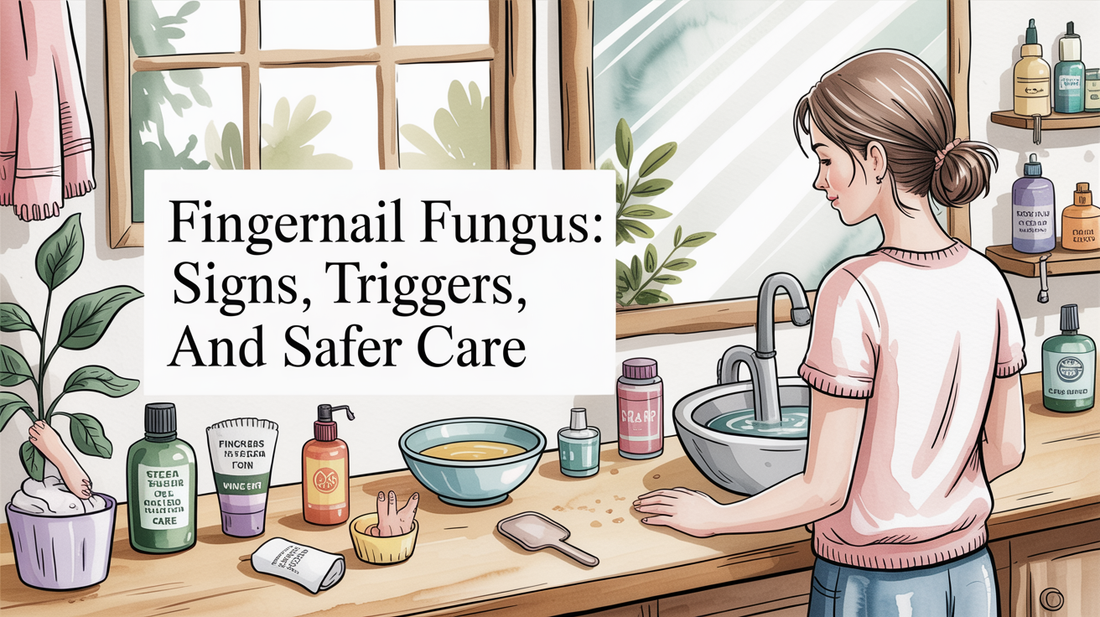Fingernail Fungus: Signs, Triggers, and Safer Care
fingernail fungus treatment, nail fungus on hands, natural fingernail remedies — Fingernail fungus can be a frustrating issue, and understanding its signs and triggers is essential for effective care. This blog is organized into three clear sections, providing practical insights into fingernail fungus treatment, nail fungus on hands, and natural fingernail remedies so you can take action tonight.
How Fingernail Fungus Differs from Toenail Fungus 🧭
Fingernail fungus, while similar to toenail fungus, presents unique challenges. It's significantly less common, affecting only about 2-5% of nail fungal infections. One crucial difference is that fingernails grow faster than toenails, which may aid in clearing infections but also increases the risk of reinfection.
Fingernail infections are often caused by yeast (Candida) instead of dermatophytes. Symptoms such as yellowing, thickening, or separation from the nail bed can occur, but they're typically less severe than toenail infections. Risk factors can include frequent hand washing, nail biting, and exposure to moisture or chemicals.
- Fingernail fungus is rarer than toenail fungus, affecting 2-5% of cases.
- Hand nails grow faster, which can help clear infections sooner but risks quicker reinfection.
- Infections may often stem from yeast, necessitating different treatment strategies.
Try It Tonight: Calm, Fresh Feet ✨
- Wash feet with warm water and mild cleanser; dry thoroughly between toes.
- Apply a small amount of Kissable Feet where needed; massage until absorbed.
- Let skin breathe; slip on breathable socks if desired. Patch-test first if you’re new to this foot cream.
Hand Hygiene Habits That Reduce Spread ✨
Maintaining proper hand hygiene is vital for preventing the spread of fingernail fungus. Unlike foot fungus, hand fungus spreads quickly through direct contact and shared surfaces. Regular hand washing with antifungal soap for at least 20 seconds is essential, especially around the nail beds and cuticles.
Keeping nails short and clean is also important to minimize fungal buildup. Avoid sharing personal items like clippers and towels, and ensure that nail care tools are disinfected before and after use. Wearing protective gloves during cleaning or gardening can also help shield your hands from fungal sources.
- Wash hands thoroughly with antifungal soap for at least 20 seconds.
- Keep nails short to prevent fungal buildup.
- Disinfect nail care tools before and after each use.
Why We Recommend a Gentle Helper 🌿
Kissable Feet is designed for quick absorption and a soothing feel, making it easy to incorporate into your nightly routine. The blend of tea tree oil, coconut, and calendula provides comfort and a clean finish.
- Fast-absorbing, non-greasy formula.
- Gentle on sensitive, overworked feet.
- Bedtime-friendly scent for a calming experience.
Moisturizing and Protecting Skin with Tea Tree Oil Foot Cream (Hands and Feet) 🔍
Tea tree oil foot cream can be a great ally for both hands and feet when dealing with fungal issues. It offers natural antifungal properties while moisturizing and protecting the skin, addressing both the infection and skin barrier function.
Tea tree oil contains terpinen-4-ol, known for its antifungal activity against common nail fungus organisms. Regular use of antifungal creams helps maintain skin integrity, preventing cracks that could allow fungi to enter. Applying a tea tree oil foot cream twice daily, especially on nail beds and surrounding areas, can be beneficial.
- Look for creams with a 5-10% tea tree oil concentration for optimal effects.
- Moisturizing helps prevent excessive dryness from treatments.
- Regular application can support skin barrier integrity.

